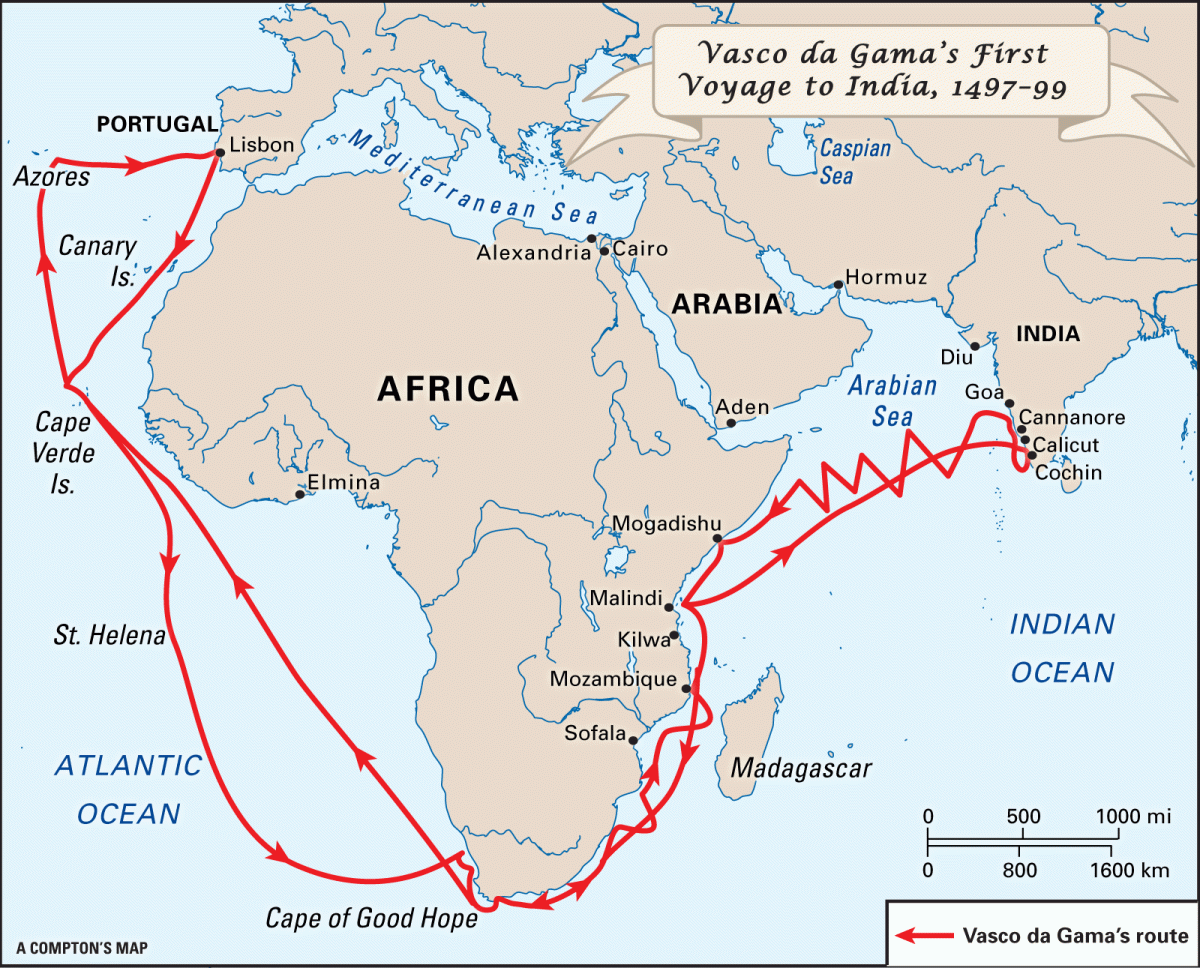For most of the Medieval ages, the Portuguese lusted for a piece of the spice trade coming from the East through the Venetians. In 1497, King João II decided the time was right and selected the nobleman Vasco da Gama to find the source of pepper, cloves, nutmeg and cinnamon. Da Gama was to follow the pathway pioneered by Bartolomeu Dias, who had learned to use the strong east winds of the mid-Atlantic to hurl himself and his crew around the African Cape of Good Hope into the Indian Ocean.
Da Gama set off on 8 July 1497 with a squadron of four well-armed ships, three years of supplies and a store of cheap goods to trade with what was assumed would be unsophisticated natives. Unfortunately, instead of boomeranging directly around the Cape, da Gama got caught in the doldrums of the central Atlantic and did not make it around the Cape. After sailing for 95 days, he landed 125 miles north of it at St Helena Bay.
Da Gama then headed down the rest of the west coast, travelled through the stormy seas around the Cape and passed the Great Fish River (Eastern Cape, South Africa) where Dias had previously anchored, before sailing into waters previously unknown to Europeans. Vasco da Gama’s first landing on the eastern coast of Africa was on Mozambique, in early March of 1498. At first, he had pleasant interactions with the local natives who were interested in trading for his cheap trinkets, but this atmosphere changed dramatically when he arrived at his first settlement of Muslim traders in Mozambique City. The local sultan was insulted by the poor quality of the brass pots, trinkets and clothing that he was offered and after a series of altercations, da Gama fled the city and continued north.
As da Gama moved up the coast, he was astonished to find a series of rich, sophisticated city states. What he had stumbled upon was the south-western periphery of the prosperous trade network that stretched all the way from Africa to India, down to Malaysia, and through the islands of Indonesia to China. He was moving into a largely Muslim world that was far more deeply layered and complex than the Portuguese had anticipated in their wildest dreams. Da Gama also made the startling discovery that Muslim trading vessels were unarmed, a situation totally alien to Mediterranean traders who were heavily armed. Da Gama realized it would be easily to prey on any Muslim trading vessels he came upon, taking gold, silver, foodstuffs and hostages from the unarmed ships.
Da Gama finds India and returns
Da Gama made a brief stop at Mombasa where the locals proved hostile and then on 14 April he arrived at the friendlier port of Malindi, whose sultan was at war with Mombasa. Da Gama was able to acquire some trade goods there and most importantly, was provided with a Gujarati pilot who showed the Portuguese the way to India on the monsoon winds.
Vasco da Gama left Malindi for India on 24 April 1498 and arrived at Calicut less than a month later. Here he found a Hindu kingdom, ruled by the king of Calicut, the zamorin or samoothiri. When Da Gama showed the Zamorin the gifts that he had brought, they were immediately rejected, but after a tense, confusing audience with the Zamorin and shows of force on both sides, da Gama was allowed to do some trading, but the Zamorin made it clear that da Gama would pay customs duty, just like any other merchant.
A frustrated da Gama left Calicut on 20 September 1498, ignoring local warnings that the monsoons had not yet turned. His ships subsequently became trapped at sea by still winds and when they did finally reach Malindi 132 days later, his sailors were again in terrible shape with scurvy. So many had died that da Gama could no longer man all of his remaining ships and the leakiest was scuttled. His two remaining ships rounded the Cape of Good Hope with little incident and reached the western coast of Africa on 25 April 1499. Here the ships got separated and headed to Portugal by different routes. Vasco da Gama stayed behind with his dying brother on Cape Verde for about a month and was the last to arrive in Lisbon in early September.
Vasco da Gama was given a hero’s welcome by the King for opening the sea route to India. His success had come at a great cost in human lives, but the small quantities of spices he had brought back signaled great future profits for the crown.
Bibliography
Crowley, R. (2015) Conquerors: How Portugal Forged the First Global Empire. Random House, New York.
Hancock, J. F. (2021) Spices, Scents and Silk: Catalysts of trade. CABI, Waddingford, Great Britain
Lunde, P. (2005) The coming of the Portuguese. Aramco World: Arab and Islamic Cultures and Connections 56(4). Available at: https://archive.aramcoworld.com/issue/200504/the.coming.of.the.portuguese.htm
For more histories of agriculture and trade: https://www.worldhistory.org/user/geneticsofberries
